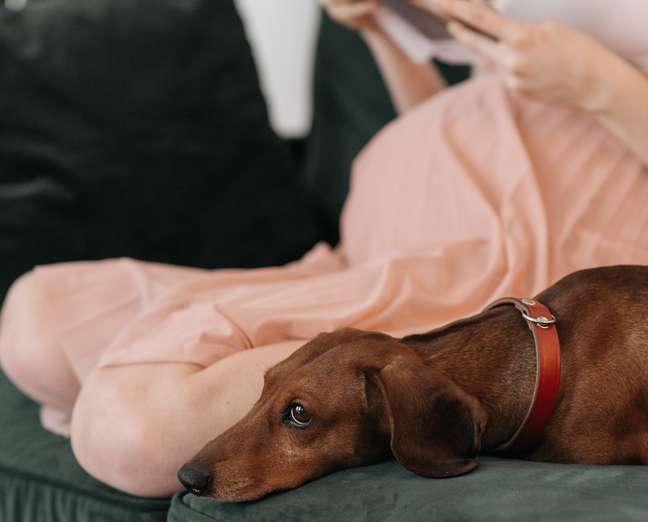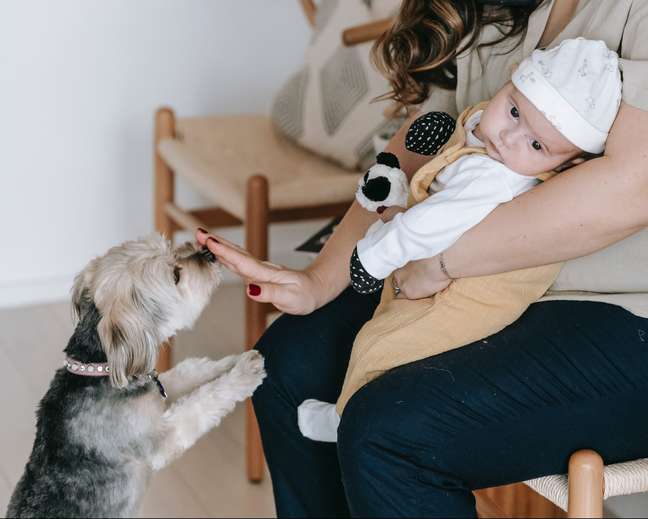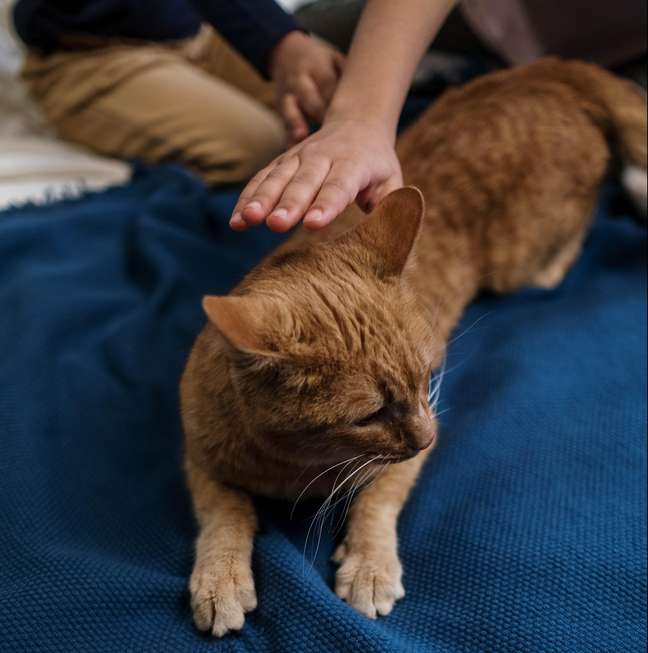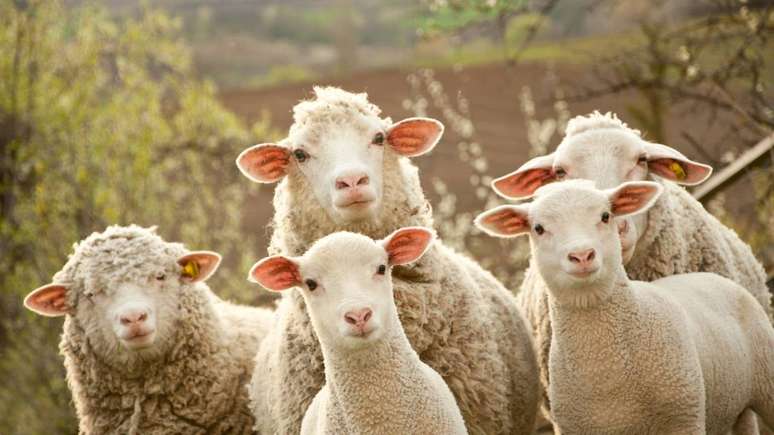We consulted with experts to compile everything prospective parents need to know before bringing their baby to a pet home.
Families who have an “extra” member in the house already know that the pets they are infinite sources of love and collaboration. However, they also require some work on the part of the owners, both in caring for the eating routine and, in some cases, depending on their behavior. For this, the discovery of a pregnancy in homes with pets usually brings a lot of fear and doubts about the child’s interaction with the animal and the adaptation of the routine.

To clarify all doubts related to the subject and reassure parents, we spoke with experts on the subject and prepared a complete guide to facilitate the baby’s arrival at the “pet friendly” home.!
Contact between children and pets is very welcome.
Before anything else, it is worth noting the advantages of living together with the child and the pet are numerous and the effort of adaptation between them will certainly be worth it..
“The interaction with animals brings various stimuli for the development of the child. Animals generate curiosity, help stimulate emotional relationships, develop motor skills, as well as a sense of care and responsibility for another living being”, explains Paulo Telles , pediatrician of the Brazilian Society of Pediatrics (SBP).
But before taking the baby indoors …
It is important to remember that it all starts in the gestation period. ” From the seventh month of pregnancy, the impact on the animal begins to occur.taking into account the hormonal change of the pregnant woman and the bond that dogs have with our energy, “explains Cleber Santos, specialist in animal behavior and CEO of Comportpet.
Added to this is all the change in the routine of the house, or for more frequent departures for exams, for example, or even for the behavior of the mother. “Often the pregnant woman was the person who paid the most attention to the animal and, with the whole situation, she begins to reduce the contact with the animal and the walking habits that she had,” adds the specialist.
From there, the family can observe some compulsive anxiety and stress behaviors in the animal caused by the changes. These include excessive barking or even licking, in the case of dogs.

Prepare the pet for the arrival of the baby
During the months of pregnancy and pregnancy planning, it is essential for parents to teach their pet basic self-control commands to prevent future accidents. “The animal has to be very well balanced so that it is welcoming and avoids impertinent behavior with the child in the house,” Cleber completes.
Many families even wonder about the possibility of leaving the most agitated animals in the care of a relative during this new phase. However, restless behaviors can be controlled very well with the help of the owner and the stimulation of the animal’s energy expenditure in other activities.
” Try to prepare the pet for changes in routine, as he too notices the news and may be anxious. It is also important to analyze the characteristics of each animal – whether it is calm or more aggressive – to help determine how close the parents should be to the baby, “recommends pediatrician Paulo Telles.
In the end, Preparation for the baby’s arrival will not be complete without talking to the vet and updating the animal’s vaccination cardOK?
How to make first contact
The first meeting between the animal and the child is the one that usually generates the most anxiety in the parents. Hence, some tips are important to bring peace of mind right now. Dogs, for example, have their keenest sense of smell and owners can explore it before the baby arrives.
“The first thing to think about is the clothes brought from the maternity ward. Parents can leave them near the place where this dog sleeps, so that he gets used to the baby’s smell and plays with the pieces. the animal will already let the child know it through the sense of smell and, when it arrives, it will not be something totally strange “, guides the specialist in animal behavior.
If owners are still quite concerned about the approach to the animal, it is recommended that a professional be present during the first meeting. On the other hand, if they feel calm for the moment, they can keep the pet limited only by the collar.
Oh, and don’t skimp on the prizes! Always try to give the pet a positive gift – with treats or cuddles – during contact with the baby, so that he understands that the arrival of the member is beneficial to his routine. “Animals learn from conditioning. So when you repeat the same thing during the same situations, it will understand the logic of repetition and start creating a habit of association.”Cleber explains.

Regulate socialization
The child brings many new things into the house: crying, different smells, decreased attention and playing with the animal … its physical, mental and recreational activities.
“A good interaction and distraction with the animal ensures that it has the most balanced energy and prevents it from being messy or messing around in the house”indicates Cleber.
The main risks are unintentional accidents. “By jumping, dropping the stroller, the mother with the baby on her lap … In the case of cats, they can nestle in the crib and even on top of the baby. These are examples of some dangerous situations,” says Telles.
Therefore, according to the pediatrician, the ideal is not to allow animals to have free access to the child’s room at the beginning and, when the interaction is allowed, count with the supervision of a responsible person, until the animal has understood how to behave with the little one.
“It is also interesting that the animal always enters with the collar, to avoid the risk of accidents. Remembering that, after the pet being with a baby, we reward him again. The idea is to leave him calm in the baby’s room, so that he understands that the behavior should be like this, “says Cleber.
Furthermore, we must not forget good hygiene habits, such as washing hands after the little one has come into contact with the animal. “A child worries us more and more about having an immature immune system. A good cleaning of the room with soap and water after the visit of the animal is essential”, instructs the pediatrician.
Already when the child is a little older, it is extremely important to teach him how to handle the animal, without pulling the ears or tail. The attitudes of the little ones must be monitored so that there is balance in the house. “Stability in education on both sides of the relationship is extremely important and recommended,” adds the animal behavior specialist.
Is there a risk of allergy?
In fact, some people are allergic to pets, and the images sometimes begin in childhood. “What happens is that pets shed hair, peel their skin and end up eliminating waste, which we cannot see with the naked eye and which we can inhale when breathing, as well as the potentially allergenic proteins in their saliva and urine, “explains allergist and immunologist Brianna Nicolletti.
Those who are hypersensitive to these residues will likely have an inflammatory reaction, with symptoms of itchy nose and eyes, sneezing, congestion, runny nose and cough, which is called an allergy. “Allergies can start at any time in life, however they are rare before six months of age,” says the immunologist.
However, there are several factors that influence the possible development of allergic reactions. Among them, the family tendency, not necessarily in relation to the hypersensitivity itself. They exist some symptoms that may be seen in contact with animals to identify an allergic condition, but it’s important to point out that we won’t always be able to be exactly sure that pets are causing allergies. Here are some examples:
- Stuffy nose, sneezing, itchy nose and clear runny nose;
- Itching, tearing and redness of the conjunctiva of the eyes;
- Transient hearing difficulty (sensation of a blocked ear);
- Headache, fatigue, irritability, loss of appetite, difficulty sleeping and difficulty concentrating on daily activities;
- Shortness of breath, wheezing and chest tightness
- Itchy, swollen skin that changes places quickly (hives)
- Eczema (coarse, scaly, red rash on the folds, neck, and face)

–
Is it possible to prevent allergies in children?
The specialist lists some measures that can reduce the risks of an allergic reaction in the little ones. Among them, the concern for hygiene and the movement of animals in the house:
- Always keep the domestic environments airy;
- Try to keep animals out of the rooms and, if necessary, out of the living areas;
- Regular baths for dogs and cats
When the child is older and the allergic condition has already been identified, it is worth betting on immunotherapy treatment, authorized from the age of two. ” Immunotherapy is known as “allergy shot”, and can be defined by the specialist based on the type of allergic profile of the patient. The procedures work by changing the response of the immune system and the treated child begins to better tolerate the allergen that previously caused a series of inflammatory reactions, ”concludes Brianna.
Source: Terra
Benjamin Smith is a fashion journalist and author at Gossipify, known for his coverage of the latest fashion trends and industry insights. He writes about clothing, shoes, accessories, and runway shows, providing in-depth analysis and unique perspectives. He’s respected for his ability to spot emerging designers and trends, and for providing practical fashion advice to readers.







